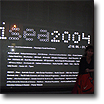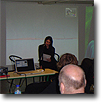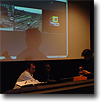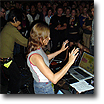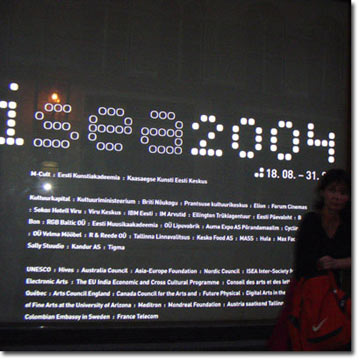ISEA: International Symposium of Electronic Art,
Aug 15, 2004 - Aug 17, 2004
Montréal, Canada
ISEA 2004: 12th International Symposium of Electronic Art
by Andrés Burbano
Helsinki, Finland. August 19 to 22.
"histories of the new", "critical interaction design", "open source software as culture", "wireless experience".
The atmosphere at the event in Helsinki, which had an interesting organizing committee headed by the Finnish artist and theorist Tapio Mäkelä, offered a range of stimulating starting points. Finland is now the country with the highest levels of connectivity in the world, cellular telephones are so popular that fixed landlines and phone booths look to be on their way out and, if that were not enough, it is the home of the Linux free and open operating system which is transforming the sociopolitical landscape of computing the world over.
Concentrated essentially in two specific places; firstly, the Kiasma museum, which played home to a extensive exhibition of interactive works and installations, and secondly, the Lume center, which hosted the conferences, where people were able to attend a great number of simultaneous keynote sessions, which covered an incredibly wide range of subjects: from wireless problems to open source programming and from interactive design to the history of new media.
Amongst the enormous offer of conferences and critical and theoretical papers, I tried to follow a specific path, looking to focus on a specific subject. In this light, I decided to find out more about the "new histories" in particular, a very promising concept that looks to carry out historical and historiographical research from a range of perspectives in terms of electronic media in relation to creative processes and cultural phenomena.
Research such as "CACHe - Recovering Computer Arts Histories", which investigates the bases of the relations between Art and computing in the UK in the period before the arrival of the PC, show, in a way, the difficulties and, likewise, the richness that a serious and creative approach to a historical subject can have. Furthermore, papers such as that from Susanne Jaschko trace a path that differ somewhat from the historical and linear and investigate further into specific aesthetic problems in contemporary works.
Among the Key Speakers, there were people of the intellectual caliber of Erkki Huhtamo who talked about connectivity without connections, i.e. the wireless and portable, from the point of view of an archeologist of the modern. The mix of reality and fantasy seen in the new wave of telecommunications, which at a commercial level promises richness and freedom of movement, seems, in theory, to contrast to a great extent with the social uses actually made of the devices. Another conference dealing with this subject also stood out, that from professor Michel Maffesoli, who also looked at telecommunications, focusing on the urban and quotidian from a sociological perspective.
In turn, the Kiasma gallery offered the chance to see the spatial proposals. Curators, in particular, showed an interest in the interactive and electronic installations. It was vital to revisit projects that had gained force over time thanks to their way of operating and of proposing the work involved in the content; for example, proposals such as "Makrolab", a cell, a laboratory located in rural areas with the aim of generating research and development processes for independent, self-sustaining life on a technological and, indeed, an energetic level.
Another spatial work dealing with self-sufficiency was the "Urban Media Hub" by the Canadian Locative Media Lab, which proposes the necessary and critical transfer of communication media and creative media interventions to the urban space.
* * *
When the problem of connectivity takes into account not only telecommunications, but also the sense of the relationships with the geographical and theoretical, proposals such as ISEA2004 are born.
|
